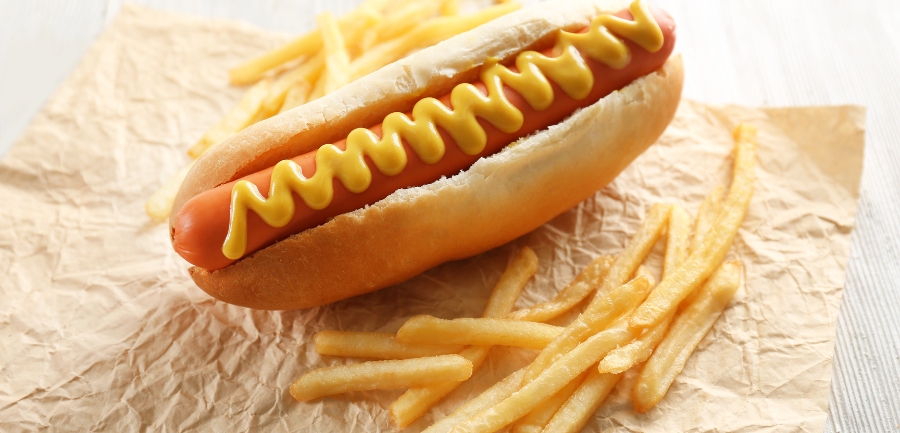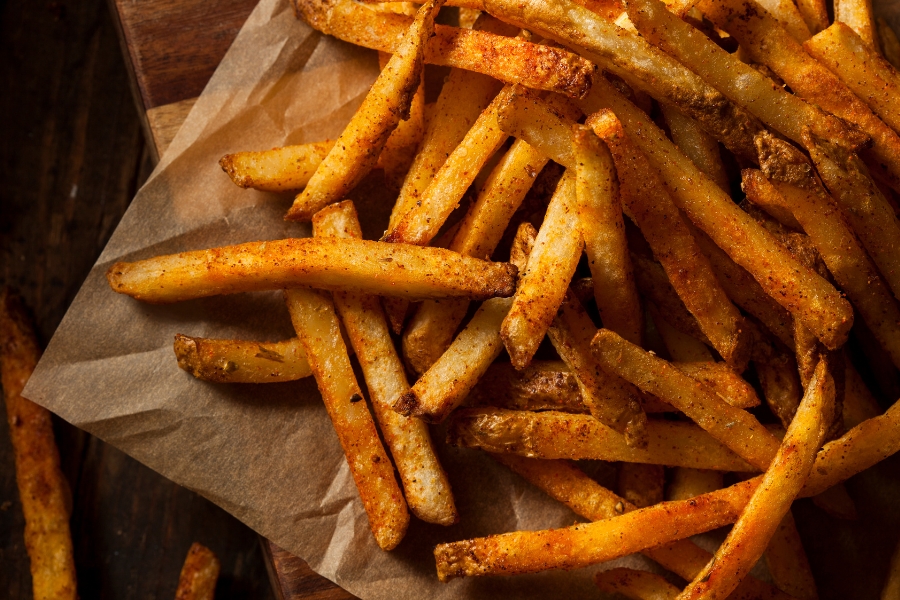Ah, hot fries! If there’s one snack that has managed to make its presence known in kitchens and cafes across the globe, it’s these fiery little wonders. I remember the first time I sank my teeth into a batch—straight out of the fryer, glistening with just the right amount of oil, and coated in that irresistible spice blend. The heat, the crunch, and the instant warmth took over my senses. They weren’t just any fries; they were an experience.
Table of Contents
Now, you might be thinking, “It’s just a snack, why the big fuss?” But anyone who’s truly delved into the world of hot fries knows that there’s an art to getting them just right. And it’s not just about how they’re made. It’s about the stories they’ve been a part of, the gatherings they’ve enhanced, and those late-night cravings they’ve satisfied.
In this post, we’re setting out on a flavorful journey—a deep dive into the world of hot fries. From understanding the nuances of crafting the perfect batch to answering some questions that might have tickled your curiosity, we’ve got it all covered. So, whether you’re a newbie wanting to try your hand at making these fiery delights or a seasoned hot fries aficionado looking for more insights, you’re in for a treat. Let’s get frying!
Hot Fries Recipe

For the uninitiated, hot fries might seem like just another snack, but ask any enthusiast, and they’ll tell you that there’s a world of difference between a good batch and a great one. Like most things in life, the devil is in the details—or in this case, the ingredients and technique. Let’s dive into the how-tos of making those perfect hot fries.
How to Make Hot Fries
Step 1: Choosing the right potato
Now, while it might be tempting to grab any old potato, remember that your fries are only as good as the spuds you start with. Russet potatoes, with their starchy content and low moisture, are your best bet. They offer a fluffy inside and a crispy exterior, the dream combo for hot fries.
Step 2: Prepping and cutting
Once you’ve got your potatoes, give them a thorough wash. Peeling is optional; some love the rustic feel of skin-on fries. When it comes to cutting, aim for consistency. Whether you’re a fan of the classic cut or the thin julienne style, ensuring each fry is roughly the same size guarantees even cooking.
Step 3: Spicing it right: Seasoning tips
Ah, the heart and soul of hot fries—the spice blend. Start with a base of paprika for that vibrant hue and kick. Add some garlic powder, onion powder, and a touch of cayenne for that fiery punch. Remember, seasoning is an art, not a science. It’s always best to taste and adjust according to your heat preference.
Step 4: Frying techniques for that perfect crunch
Heat up a good quality oil (like canola or vegetable) in a deep fryer or a deep pan. The ideal temperature? About 350°F (175°C). Once it’s hot, gently add the fries, ensuring not to overcrowd the pan. Fry until golden and crispy, typically 3-5 minutes, then drain on paper towels. While still hot, sprinkle your seasoning blend and give them a good toss.
Hot Fries Ingredients
Potatoes: The heart of hot fries
It’s all about the spud! As mentioned, Russet potatoes are your top choice. Their starchy texture lends itself beautifully to frying, ensuring a crispy finish every time.
Essential seasonings: Bringing the heat
Beyond the paprika, garlic powder, and cayenne trio, you can also consider adding a sprinkle of salt or even a hint of sugar for a sweet-spicy contrast. The world is your oyster when it comes to spices, but remember, balance is key.
Optional add-ins for a twist
Feeling experimental? Toss in some grated Parmesan cheese for an umami kick. Or perhaps a squeeze of lime and a sprinkle of chopped cilantro for a zesty, fresh take. Experiment and find your signature blend!
Hot Dog and Fries

Few things scream classic comfort food like the combination of a sizzling hot dog alongside a batch of crispy fries. When done right, it’s a duo that transcends age and geography, bringing smiles from backyard barbecues to urban eateries. Let’s dive deeper into creating this iconic pairing.
How to Pan Fry a Hot Dog
Preparing the pan: Tips for the best results
Before we get the hot dog sizzling, the pan needs some attention. Opt for a non-stick skillet or cast iron, if you have one. A touch of oil or a small pat of butter can enhance flavor, but be careful not to overdo it—a little goes a long way. Heat the pan over a medium flame until you can feel the warmth when hovering your hand above.
Cooking the hot dog: Timing and techniques
Once the pan is ready, place the hot dog in. If you’ve ever wondered about those perfect grill marks on hot dogs, here’s the secret: Rotate the hot dog every 30 seconds, ensuring an even, caramelized cook. Typically, a pan-fried hot dog takes about 4-6 minutes to reach perfection, but always trust your eyes and nose over a timer!
Serving suggestions: Making the perfect pair
Once that hot dog is gorgeously golden and juicy, it’s time to think about presentation. Consider toasting the bun in the same pan for an added layer of texture. As for the fries, serve them alongside, perhaps in a paper cone or a basket for that authentic feel. Don’t forget your favorite condiments! A squirt of mustard or a dollop of relish can elevate the entire dish.
Bacon Cheddar Hot Fries

Introduction to this flavorful variant
Enter Bacon Cheddar Hot Fries—a sinful blend of smoky, cheesy goodness coating our beloved hot fries. This variant is for those days when plain hot fries just won’t cut it when you’re craving something extra indulgent.
Ingredients needed for the mix
- Crisp bacon strips, finely crumbled
- Shredded cheddar cheese (preferably sharp)
- Your prepared hot fries
- Optional: chives or green onions for a hint of freshness
Combining bacon and cheddar: A step-by-step process
- Prep the fries: Make sure your hot fries are freshly out of the fryer and still warm. This helps in melting the cheese.
- Layer the goodness: In a large bowl, sprinkle a generous amount of cheddar cheese over the fries. Follow this with a handful of crumbled bacon.
- Mix and melt: Toss the fries gently to distribute the cheese and bacon evenly. If you have an oven or air fryer handy, a quick blast (just a minute or two) will help melt the cheese and bind everything together.
- Serve immediately: Plate up while still hot, and sprinkle with chives or green onions if using.
Can Dogs Eat Hot Fries?

We all know that irresistible look our furry friends give us when we’re munching on something delicious. And more often than not, we’re tempted to share a bit of our snack. But when it comes to hot fries, is it a good idea? Let’s delve into the do’s and don’ts of sharing this spicy treat with our four-legged pals.
- Understanding the ingredients and potential hazards
The prime allure of hot fries—aside from their crunch—is the spice blend that gives them their kick. But what’s a delightful zing for us can be a cause of distress for dogs. Their digestive systems are different from ours, and certain ingredients can be harmful to them.
- Spices and seasonings: What’s harmful?
Many of the seasonings we enjoy in hot fries, particularly onion and garlic powder, can be toxic to dogs. Even small amounts can lead to gastrointestinal upset or, in larger quantities, serious health complications. The spicy nature of these fries, thanks to ingredients like cayenne or chili powder, can also irritate a dog’s stomach, leading to discomfort or even vomiting.
- Portion control and occasional treats
If you ever find yourself thinking, “Just one won’t hurt,” remember that dogs, especially smaller ones, can be much more sensitive to certain foods than we are. Even if the harmful ingredients were removed, the high salt and oil content in fries aren’t ideal for their diet. So, if you really must share, ensure it’s a tiny, unseasoned piece and only on rare occasions.
- Safer alternatives for your furry friend
Instead of giving in to those pleading eyes and sharing your fries, consider having dog-friendly treats on hand. Simple boiled or baked potatoes (without any seasoning) can be a safe and delicious alternative. There are also numerous dog treats available in stores that mimic the texture or flavor of human snacks without the harmful ingredients.
Can You Eat Hot Fries with Braces?

Braces come with their own set of dietary do’s and don’ts, and often, it feels like the list of forbidden foods is endless. But what about our beloved hot fries? Can you indulge without damaging your orthodontic investment? Here’s a closer look at what brace-wearers need to know when it comes to this spicy treat.
Potential risks involved
The primary concern with hot fries isn’t their spice level but their crunch. Braces are designed to be sturdy, but certain foods can put undue stress on the brackets and wires. Eating hard or crunchy foods like hot fries can lead to broken brackets, bent wires, or even minor injuries to the mouth’s soft tissue. Additionally, the spices and seasonings, although flavorful, can get trapped easily, increasing the risk of cavities, especially when wearing braces.
Tips for consuming with care
If you’re not ready to part with hot fries during your braces journey, there are still ways to minimize the risks:
- Go for softer fries: Instead of the super crispy variants, opt for fries that have a softer texture. This might mean making them at home where you can control the frying time or choosing certain brands or styles over others.
- Break them up: Rather than biting directly into a fry, consider breaking them into smaller, manageable pieces and placing them in the mouth. This reduces the direct pressure on the front brackets and teeth.
- Be mindful of temperature: Along with the texture, be cautious of extremely hot fries. Hot foods can temporarily soften the orthodontic glue that holds the brackets.
Cleaning braces post-snack: Best practices
Ensuring your braces are clean after munching on seasoned fries is essential:
- Rinse immediately: After you’re done eating, swish some water around your mouth to dislodge any particles stuck around or between your braces.
- Use a braces-friendly toothbrush: These toothbrushes often have a V-shaped cut that fits around brackets. Brush gently but thoroughly.
- Floss with care: Use an orthodontic flosser or a floss threader to navigate the spaces between wires and teeth. This will help remove any trapped food particles.
- Consider a mouthwash: A fluoride mouthwash can help fight against potential cavities and keep your mouth feeling fresh.
While braces might come with their challenges, they don’t necessarily mean bidding farewell to all your favorite snacks. With a little care and precaution, you can still enjoy treats like hot fries in moderation. Remember, it’s always best to consult with your orthodontist or dentist about any dietary concerns related to your braces. They can provide personalized advice tailored to your treatment plan.
To Wrap It Up!
Hot fries are more than just a snack—they’re a delightful experience packed with flavor and memories. While diving into their delicious world, it’s essential to be informed, whether considering the health of our furry pals or the intricacies of dental care with braces. The beauty of knowledge lies in its power to let us enjoy life’s pleasures responsibly. So the next time you reach for that crispy, spicy treat, you’ll do so with confidence, appreciation, and a sprinkle of wisdom. Here’s to many more crunchy moments! Cheers!
FAQs
What are hot fries?
Hot fries are spicy, seasoned potato snacks, often deep-fried to achieve a crispy texture and flavored with a blend of spices for a fiery kick.
Are hot fries baked?
While traditional hot fries are usually deep-fried, there are baked versions available that offer a crunch with less oil and fat.
Are hot fries healthy?
In moderation, hot fries can be a tasty treat. However, due to their salt, spice, and frying process, they aren’t considered healthy food and should be consumed sparingly.
Can I eat fries every day?
Eating fries daily isn’t recommended due to their high fat and sodium content. Regular consumption can contribute to health issues, so it’s best to enjoy them occasionally.

